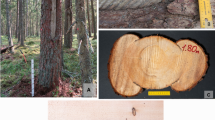Abstract
In forest stands, Picea abies is commonly subjected to logging and bark stripping injuries. Most mechanical wounds do not exceed 300 cm2, but their pathological consequences are unclear. The aim of the study was to estimate the rate of wound occlusion and the probability of decay in P. abies stems in relation to initial wound size and wounding season. The study included forty-five stems with 1-, 2-, 3-, 4- and 5-cm-wide by 15-cm-long wounds (15–75 cm2), and eighty-three stems with 15-cm-wide by 20-cm-long wounds (300 cm2), made either in January or in August. After 19–21 years, each wound was assessed for occlusion rate and the presence of decay. All 1- to 2-cm-wide wounds were occluded, compared to 58–70% of the 3- to 4-cm-wide wounds, 25% of the 5-cm-wide wounds, and 0% of the 15-cm-wide wounds. On average, it took 3.6, 5.5, 10.4, 12.7 and 14.7 years to occlude wounds ranging in size from 1- to 5-cm-wide, respectively. After 21 years, the observed size of wounds comprising an initial area of 300 cm2 ranged between 14 and 481 cm2. Wounding season and stem DBH had no impact on wound healing. Wound decay incidence correlated positively with the initial width of injury (r = 0.925; P < 0.05). All 1- to 2-cm-wide wounds lacked any decay, while the proportions of decay among 3-, 4-, 5- and 15-cm-wide wounds were 58.3, 50.0, 83.3 and 100%, respectively. Length of decay comprised 35–225 cm. Consequently, wounds on P. abies stems greater than 5 cm width are unlikely to be occluded and more prone to decay development.


Similar content being viewed by others
References
Bazzigher G (1973) Wundfäule in Fichtenwaldungen mit alten Schälschäden. Eur J For Path 3:71–82
Beitzen-Heineke I, Dimitri L (1981) Rückeschäden: Entstehung und die Möglichkeiten ihrer Verhütung. Allg ForstZeitschr 32:278–280
Bonnemann I (1979) Untersuchungen über die Entstehung und Verhütung von ‘Wundfäulen’ bei der Fichte. Dissertation, Georg August Universität, Göttingen
Dimitri L (1993) Zur Diskussion um Wildschadenvorbeugung. Der Wald Berlin 43:170–173
Eidmann FE (1952) Wertminderung von Fichtenbeständen durch den Schälschaden des Rotwildes. Forstarchiv 23:65–69
Hasek J (1965) Bark stripping and logging damages as the two most important problems in contemporary forest protection. Acta Universitatis Agriculturae, Brno- Series C 2:93–110 (in Czech, with English abstract)
Hildebrandt G (1959) Beobachtungen über die Verteilung des Schälschadens in Fichtenbeständen. Allg Forst- u Jagdztg 130:213–218
Kiffner C, Rössiger E, Trisl O, Schultz R, Ruhe F (2008) Probability of recent bark stripping damage by red deer (Cervus elaphus) on Norway spruce (Picea abies) in low mountain range in Germany—a preliminary analysis. Silva Fenn 42:125–134
Löffler H (1975) Zur Ausbreitung der Wundfäule in der Fichte. Forstw Cbl 94:175–183
Pach M (2008) The rate of bark-stripping wound closure in fir and some factors affecting it. Sylwan 4:46–58 (in Polish, with English summary)
Repsys J, Kenstavicius J, Kuliesis A (1983) Handbook for forest inventory. Mokslas, Vilnius (in Lithuanian)
Schedrova VI (1959) Logging damage and wound decay on regrowth of spruce. Trudy Karelskogo Filiala AN SSSR 16:126–135 (in Russian)
Schimitschek E (1975) Betrachtung über einige Schäden am Walde. Allg Forst- u Jagdztg 146:150–153
Seifert T (2007) Simulating the extent of decay caused by Heterobasidion annosum s. l. in stems of Norway spruce. Forest Ecol Manage 248:95–106
Seifert T, Nickel M, Pretzsch H (2010) Analysing the long-term effects of artificial pruning of wild cherry by computer tomography. Trees Struct Funct 24:797–808
Soukup F, Temmlova B (1977) Influence of mechanized technological processes of logging and skidding on an injury rate of the standing trees. Lesnictvi 23:465–478 (in Czech, with English abstract)
Staines BW, Welch D (1984) Habitat selection and impact of red (Cervus elaphus L.) and roe (Capreolus capreolus L.) deer in a Sitka spruce plantation. Proc R Soc Edinb 82B:303–319
Steyrer G (1992) Ausmass und Bewertung von Stammfäule in einem Fichtenforstbetrieb. Cbl ges Forstw 109:221–249
Vasiliauskas R (1989) Wound decay of Norway spruce in forests of Lithuania and possibilities to reduce its pathological impact. Dissertation, Leningrad Forest Technology Academy (in Russian)
Vasiliauskas R (1993) Wound decay of Norway spruce associated with logging injury and bark stripping. Proc Lith Forest Res Inst 33:144–156
Vasiliauskas R (1994) Wound healing rate and its influence on spread of decay in spruce. Proc Lith Forest Res Inst 34:207–212
Vasiliauskas R (1998) Ecology of fungi colonizing wounds of Norway spruce, with special emphasis on Stereum sanguinolentum. Dissertation, Swedish University of Agricultural Sciences
Vasiliauskas R (2001) Damages to trees due to forestry operations and its pathological significance in temperate forests: a literature review. Forestry 74:319–336
Verheyden H, Ballon P, Bernard V, Saint-Andrieux C (2006) Variations in bark-stripping by red deer Cervus elaphus across Europe. Mammal Rev 36:217–234
Vospernik S (2006) Probability of bark stripping damage by red deer (Cervus elaphus) in Austria. Silva Fenn 40:589–601
Welch D, Scott D, Staines BW (1997) Bark stripping damage by red deer in a Sitka spruce forest in Western Scotland. III. Trends in wound condition. Forestry 70:113–120
Zycha H (1962) Hymenomycetes. In: Sorauer P, Appel O, Blunck H, Rademacher B, Richter H (eds) Handbuch der Pflanzenkrankheiten. Parey-Verlag, Berlin, pp 550–575
Acknowledgments
This study was supported by Science Council of Lithuania (Grant No. T-54/09). We thank Dr. Michelle Cleary for language revision.
Conflict of interest
The authors declare that they have no conflict of interest.
Author information
Authors and Affiliations
Corresponding author
Additional information
Communicated by T. Seifert.
Rights and permissions
About this article
Cite this article
Vasaitis, R., Lygis, V., Vasiliauskaite, I. et al. Wound occlusion and decay in Picea abies stems. Eur J Forest Res 131, 1211–1216 (2012). https://doi.org/10.1007/s10342-011-0592-3
Received:
Revised:
Accepted:
Published:
Issue Date:
DOI: https://doi.org/10.1007/s10342-011-0592-3




